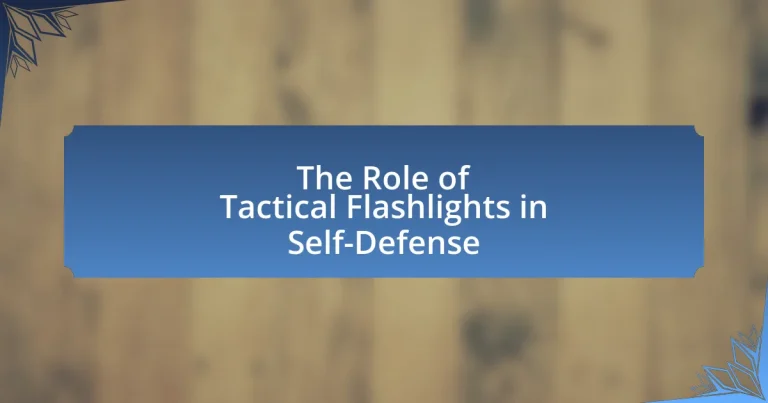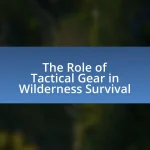Tactical flashlights are high-intensity portable lighting devices specifically designed for self-defense, providing illumination in low-light environments to identify threats and navigate safely. They differ from regular flashlights through their durability, brightness, and additional features like strobe functions that can disorient attackers. Key benefits include enhancing situational awareness, deterring potential threats, and offering psychological advantages such as increased confidence. The article explores the essential specifications, design considerations, and best practices for using tactical flashlights effectively in self-defense scenarios, emphasizing their role as vital tools for personal safety.
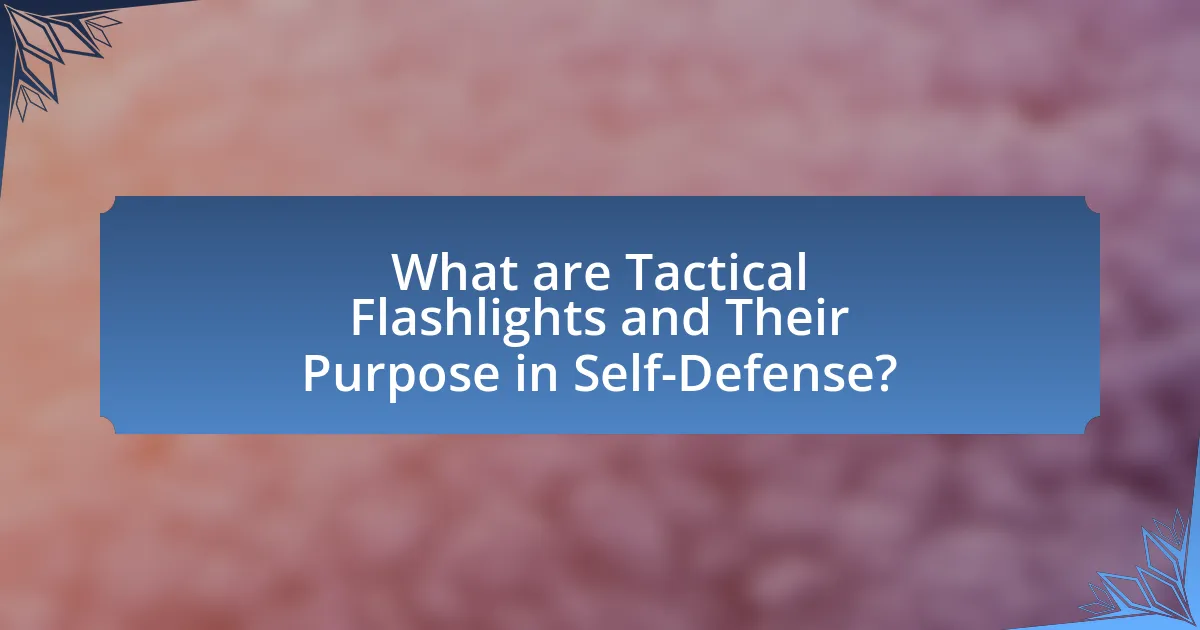
What are Tactical Flashlights and Their Purpose in Self-Defense?
Tactical flashlights are high-intensity portable lighting devices designed for use in self-defense situations. Their primary purpose is to provide illumination in low-light environments, allowing individuals to identify threats and navigate safely. Additionally, tactical flashlights often feature a strobe function that can disorient an attacker, giving the user a critical advantage during a confrontation. The durability and compact design of these flashlights make them practical tools for personal safety, as they can be easily carried and deployed when needed.
How do Tactical Flashlights differ from regular flashlights?
Tactical flashlights differ from regular flashlights primarily in their design and functionality, emphasizing durability, brightness, and versatility for self-defense situations. Tactical flashlights are typically constructed from aircraft-grade aluminum, making them more resistant to impact and weather conditions compared to standard plastic or lower-grade metal flashlights. They often feature higher lumen outputs, providing intense illumination that can temporarily blind an assailant, which is a critical aspect in self-defense scenarios. Additionally, tactical flashlights frequently include features such as strobe modes and a focused beam, enhancing their effectiveness in emergency situations. These characteristics make tactical flashlights not only reliable illumination tools but also essential self-defense devices.
What features make Tactical Flashlights suitable for self-defense?
Tactical flashlights are suitable for self-defense primarily due to their high lumen output, durability, and strobe function. The high lumen output, often exceeding 1,000 lumens, allows users to temporarily blind an assailant, providing a critical moment to escape or counter. Their durable construction, typically made from aircraft-grade aluminum, ensures they can withstand impact and harsh conditions, making them reliable in emergencies. Additionally, the strobe function can disorient attackers, further enhancing the user’s ability to defend themselves. These features collectively make tactical flashlights effective tools for personal safety and self-defense situations.
How does brightness impact the effectiveness of Tactical Flashlights?
Brightness significantly impacts the effectiveness of tactical flashlights by determining their visibility range and ability to disorient potential threats. Higher brightness levels, measured in lumens, allow tactical flashlights to illuminate larger areas and penetrate darkness more effectively, which is crucial in self-defense situations. For instance, a flashlight with 1000 lumens can illuminate objects up to 200 meters away, providing a tactical advantage by enhancing situational awareness. Additionally, bright light can temporarily blind an assailant, giving the user critical moments to escape or respond. Therefore, the brightness of a tactical flashlight directly correlates with its utility in self-defense scenarios.
Why are Tactical Flashlights considered essential for personal safety?
Tactical flashlights are considered essential for personal safety because they provide illumination in dark environments, enabling individuals to identify potential threats and navigate safely. Their high lumen output, often exceeding 1,000 lumens, allows users to illuminate large areas or focus on specific objects, enhancing situational awareness. Additionally, many tactical flashlights feature strobe modes that can disorient an attacker, providing a critical advantage in self-defense scenarios. The durability and compact design of these flashlights make them easy to carry and reliable in emergencies, further solidifying their role as a vital tool for personal safety.
What scenarios can benefit from the use of Tactical Flashlights?
Tactical flashlights are beneficial in scenarios such as self-defense situations, outdoor activities, emergency preparedness, and law enforcement operations. In self-defense, they can temporarily blind an attacker, providing a critical moment to escape or counter. During outdoor activities like camping or hiking, they enhance visibility and safety in low-light conditions. In emergencies, tactical flashlights serve as reliable light sources for signaling or navigating through dark environments. Law enforcement personnel utilize them for illuminating dark areas during patrols or investigations, ensuring safety and effectiveness in their operations.
How do Tactical Flashlights enhance situational awareness?
Tactical flashlights enhance situational awareness by providing bright, focused illumination that allows users to identify potential threats and navigate their environment effectively. The high lumen output of tactical flashlights, often exceeding 1,000 lumens, enables users to see clearly in low-light conditions, which is crucial for assessing surroundings during self-defense situations. Additionally, many tactical flashlights feature strobe modes that can disorient an attacker, further improving the user’s ability to maintain awareness and react appropriately. Studies indicate that visibility significantly impacts threat detection, underscoring the importance of effective lighting in enhancing situational awareness.
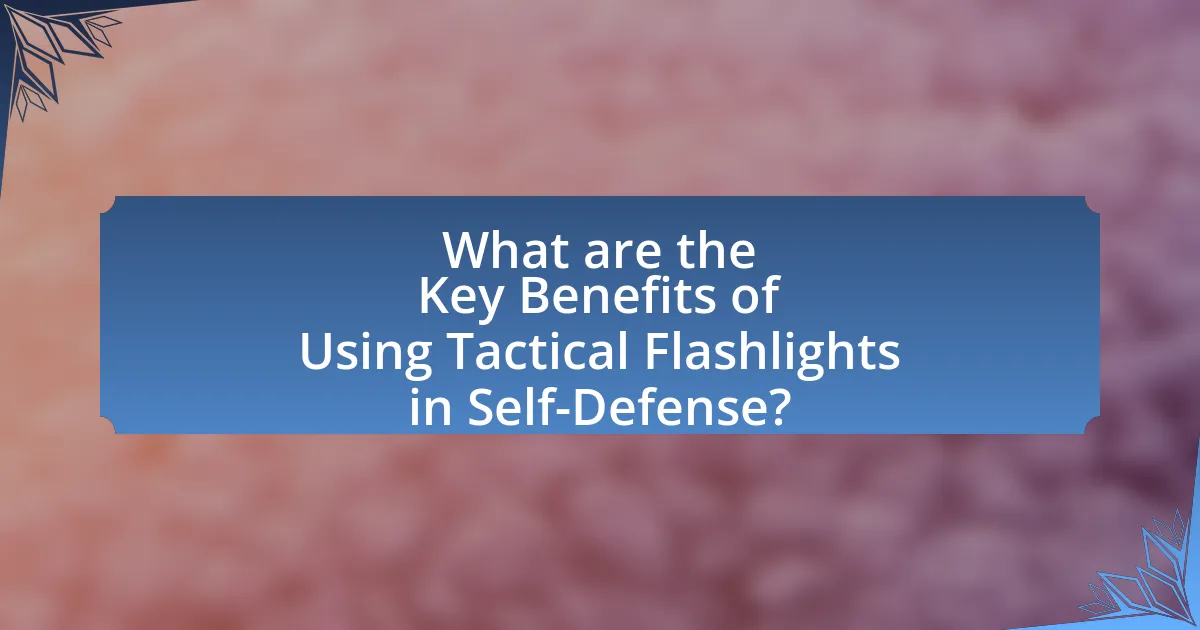
What are the Key Benefits of Using Tactical Flashlights in Self-Defense?
Tactical flashlights provide several key benefits in self-defense situations, primarily enhancing visibility and disorientation of potential threats. Their high lumen output allows users to illuminate dark areas, making it easier to identify threats and navigate safely. Additionally, the intense beam can temporarily blind an assailant, giving the user a critical advantage to escape or counterattack. Tactical flashlights are often designed to be durable and water-resistant, ensuring reliability in various conditions. Furthermore, many models feature strobe functions that can disorient attackers, increasing the effectiveness of self-defense efforts. These features collectively make tactical flashlights a valuable tool for personal safety and self-defense.
How can Tactical Flashlights deter potential threats?
Tactical flashlights can deter potential threats by emitting a powerful beam of light that temporarily blinds and disorients an aggressor. This blinding effect can create a critical moment for the intended target to escape or defend themselves. Studies indicate that bright light can impair vision for several seconds, giving individuals a tactical advantage in self-defense situations. Additionally, the presence of a tactical flashlight can signal preparedness and assertiveness, potentially discouraging an attacker from proceeding.
What role does blinding light play in self-defense situations?
Blinding light serves a critical role in self-defense situations by temporarily disorienting an attacker, providing the defender with a crucial opportunity to escape or counterattack. Tactical flashlights, which emit intense beams of light, can create a momentary visual impairment, hindering the attacker’s ability to see and react effectively. Studies indicate that exposure to bright light can disrupt an individual’s focus and coordination, making it difficult for them to pursue or engage in aggressive actions. This tactical advantage is particularly effective in low-light environments, where the sudden illumination can shift the dynamics of a confrontation, allowing the defender to gain control of the situation.
How can Tactical Flashlights assist in emergency situations?
Tactical flashlights assist in emergency situations by providing reliable illumination, which is crucial for visibility and safety. In low-light conditions, these flashlights can help individuals navigate hazardous environments, identify threats, and signal for help. For instance, a study by the National Institute of Justice highlights that effective lighting can enhance situational awareness and reduce the risk of accidents during emergencies. Additionally, many tactical flashlights feature strobe functions that can disorient potential attackers, providing a critical advantage in self-defense scenarios.
What are the psychological advantages of carrying a Tactical Flashlight?
Carrying a Tactical Flashlight provides psychological advantages such as increased confidence and a sense of security. The presence of a reliable light source can enhance an individual’s perception of control in potentially threatening situations, reducing anxiety and fear. Studies indicate that individuals who feel prepared and equipped are more likely to exhibit assertive behavior, which can deter potential threats. Furthermore, the ability to illuminate dark areas can foster a sense of vigilance, allowing individuals to assess their surroundings more effectively, thereby enhancing their overall situational awareness.
How does having a Tactical Flashlight influence personal confidence?
Having a tactical flashlight enhances personal confidence by providing a reliable tool for self-defense and situational awareness. The presence of a tactical flashlight allows individuals to illuminate dark areas, identify potential threats, and assert control in uncertain environments. Studies indicate that individuals equipped with self-defense tools, such as tactical flashlights, report higher levels of confidence and preparedness in potentially dangerous situations. This increased confidence stems from the psychological effect of having a means to deter threats, as well as the practical ability to navigate and assess surroundings effectively.
What impact does visibility have on the perception of safety?
Visibility significantly enhances the perception of safety by allowing individuals to better assess their surroundings and identify potential threats. When environments are well-lit, people feel more secure because they can see and react to any dangers more effectively. Research indicates that areas with higher visibility, such as those illuminated by tactical flashlights, correlate with lower crime rates, as offenders are less likely to act in well-lit spaces where they can be easily observed. This relationship between visibility and safety perception is supported by studies showing that increased lighting in public spaces reduces fear and enhances feelings of security among community members.
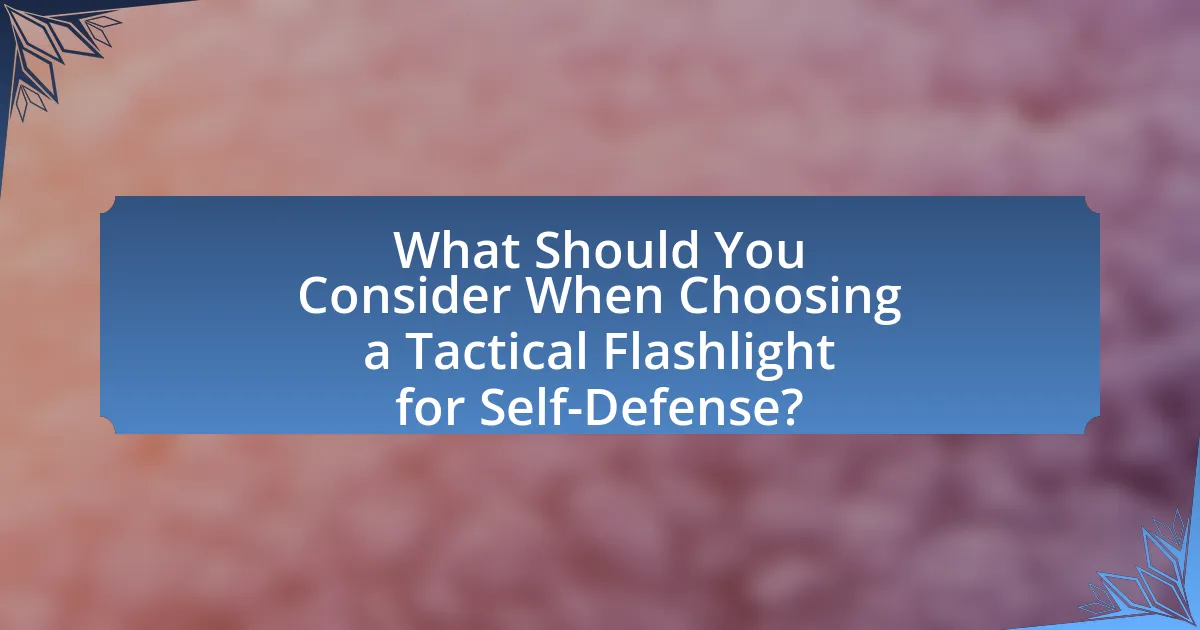
What Should You Consider When Choosing a Tactical Flashlight for Self-Defense?
When choosing a tactical flashlight for self-defense, consider brightness, durability, size, and features. Brightness, measured in lumens, is crucial as a higher lumen count provides better visibility and can temporarily blind an attacker. Durability is essential; look for flashlights made from aircraft-grade aluminum or high-strength polymer to withstand impact and harsh conditions. Size matters; a compact flashlight is easier to carry and deploy quickly. Additionally, features such as strobe modes can disorient an assailant, while water resistance ensures functionality in various environments. These factors collectively enhance the effectiveness of a tactical flashlight in self-defense situations.
What specifications are important in a Tactical Flashlight?
Important specifications in a tactical flashlight include brightness measured in lumens, durability rated by impact resistance and water resistance, battery life, and beam distance. Brightness, typically ranging from 200 to 1,000 lumens, determines visibility in various conditions, while durability ensures the flashlight can withstand harsh environments, often rated to military standards (e.g., IPX7 for water resistance). Battery life, which can vary from a few hours to several days depending on the mode used, is crucial for extended use. Beam distance, usually measured in meters, indicates how far the light can effectively illuminate, with tactical flashlights often reaching distances of 100 meters or more. These specifications collectively enhance the flashlight’s effectiveness in self-defense scenarios.
How does battery life affect the usability of Tactical Flashlights?
Battery life significantly impacts the usability of tactical flashlights by determining how long the device can operate effectively during critical situations. A longer battery life ensures that users can rely on the flashlight for extended periods, which is essential in self-defense scenarios where visibility and illumination are crucial. For instance, tactical flashlights often utilize high-capacity lithium-ion batteries that can provide several hours of continuous use, enhancing their effectiveness in emergencies. Conversely, a flashlight with a short battery life may fail when needed most, compromising safety and situational awareness. Therefore, the reliability of tactical flashlights in self-defense is directly linked to their battery performance.
What are the ideal materials for durability in Tactical Flashlights?
The ideal materials for durability in tactical flashlights are aircraft-grade aluminum and high-impact plastic. Aircraft-grade aluminum provides excellent strength-to-weight ratio and resistance to corrosion, making it suitable for rugged environments. High-impact plastic, often used in the housing of tactical flashlights, offers shock resistance and can withstand drops and impacts. These materials ensure that tactical flashlights can endure harsh conditions while maintaining functionality, as evidenced by their widespread use in military and law enforcement applications where reliability is critical.
How do different designs of Tactical Flashlights cater to self-defense needs?
Different designs of tactical flashlights cater to self-defense needs by incorporating features such as high lumen output, strobe functions, and durable construction. High lumen output allows for blinding an assailant, providing a critical moment to escape or defend oneself. Strobe functions can disorient attackers, enhancing the user’s ability to gain control of a situation. Additionally, durable construction ensures that the flashlight can withstand impact and adverse conditions, making it reliable in emergencies. These design elements collectively enhance personal safety and effectiveness in self-defense scenarios.
What are the advantages of compact versus full-sized Tactical Flashlights?
Compact tactical flashlights offer portability and ease of concealment, making them ideal for everyday carry and self-defense situations. Their lightweight design allows users to easily store them in pockets or bags, ensuring quick access when needed. In contrast, full-sized tactical flashlights provide greater brightness and longer battery life, which can be crucial in high-stress scenarios where visibility is paramount. The larger size often accommodates more powerful bulbs and larger batteries, enhancing performance in critical situations. Thus, the choice between compact and full-sized tactical flashlights depends on the user’s specific needs for portability versus power.
How does the grip design influence usability in self-defense scenarios?
Grip design significantly influences usability in self-defense scenarios by enhancing control and reducing the likelihood of slippage during high-stress situations. A well-designed grip allows for a secure hold, which is crucial when using tactical flashlights as defensive tools. For instance, ergonomic grips that conform to the hand’s natural shape can improve dexterity and maneuverability, enabling users to effectively illuminate threats while maintaining readiness for defensive actions. Research indicates that grips with textured surfaces can further enhance friction, providing additional stability and confidence in grip during rapid movements or when under duress.
What are some best practices for using Tactical Flashlights in self-defense?
Best practices for using tactical flashlights in self-defense include utilizing the flashlight to disorient an attacker, maintaining a firm grip for control, and using the strobe function to create confusion. The bright beam can temporarily blind an assailant, giving the user a critical advantage to escape or counterattack. A study by the National Institute of Justice highlights that effective use of light can enhance personal safety by increasing visibility and awareness in low-light situations. Additionally, tactical flashlights should be easily accessible, allowing for quick deployment in emergencies. Regular training on how to use the flashlight effectively in self-defense scenarios can further improve readiness and response.
How can you effectively incorporate a Tactical Flashlight into your self-defense strategy?
To effectively incorporate a Tactical Flashlight into your self-defense strategy, utilize its brightness to disorient potential attackers. A Tactical Flashlight typically emits a high lumen output, often exceeding 1,000 lumens, which can temporarily blind an assailant, giving you crucial seconds to escape or defend yourself. Additionally, the flashlight’s sturdy construction allows it to be used as a striking tool if necessary, enhancing your physical defense capabilities. Studies indicate that the element of surprise and the ability to create distance are vital in self-defense situations, making the Tactical Flashlight an essential tool for personal safety.
What are common mistakes to avoid when using Tactical Flashlights for self-defense?
Common mistakes to avoid when using tactical flashlights for self-defense include failing to practice with the flashlight, using it as a primary weapon instead of a tool, and neglecting to consider the brightness level. Practicing with the flashlight ensures familiarity with its operation and effectiveness in high-stress situations. Relying solely on the flashlight can lead to vulnerability, as it should complement other self-defense strategies. Additionally, using a flashlight with insufficient brightness may not effectively disorient an attacker, as studies show that a brightness of at least 1000 lumens is often necessary to achieve this effect.
